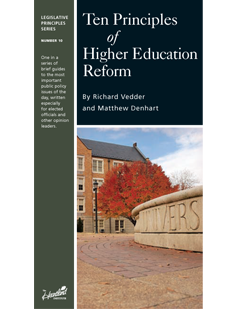The dissemination and expansion of knowledge is important to the advancement of our civilization and our nation’s economic productivity, yet the cost of that effort is considerable and rising dramatically. Better efficiency in delivering higher education would increase the nation’s economic growth and living standards.
The United States spends more than $430 billion annually on various forms of postsecondary education the equivalent of 3 percent of the nation’s total economic output triple the proportion of a half-century ago. This chapter offers innovative ways that higher education, also known as postsecondary education, could be reformed to improve outcomes and lower costs. “Postsecondary education” is defined rather broadly, referring to American degree-granting colleges and universities.
There is a widespread feeling that university training is important for economic success at the individual level as well as to the nation, yet increasing evidence suggests U.S. institutions of higher education are less efficient and decreasingly effective at creating the foundations for such success:
- The cost of obtaining a four-year degree has more than doubled since 1975 in inflation-adjusted dollars.
- Statistics from the 2003 National Assessment of Adult Literacy suggest college graduates have a lower level of reading comprehension than their counterparts of a decade ago.
- Although difficult to quantify, by any reasonable measure productivity in higher education is at best stagnant, and probably falling.
- The typical college student of today spends about 30 percent less time on academic pursuits than his or her counterpart of a half-century ago, as grade inflation makes it easier to seem to perform well with less work.
- 42 percent of students enrolling in bachelor’s degree programs full-time fail to earn a degree within six years.
- Falling teaching loads have led to a proliferation of articles published in obscure academic journals that few persons read.
- Universities devote more of their budgets to non-instructional pursuits than previously, including swollen and well-paid bureaucracies, country club-like recreational facilities, and research that has low value outside the academic community.
- The effort to have everyone obtain a college degree has led to many workers becoming over-trained for the low-skill jobs they take after graduation.
- Students are burdened with excessive debt from college training, sometimes larger than can be sustained on their modest post-college incomes.
Can something be done to reverse these trends? Adherence to sound principles can lead to reforms of higher education that make it more affordable, more productive, more efficient, and more useful to society. Alternatives to existing modes of educational delivery can and are being developed, including training more appropriate for the aptitudes and interests of students. The ten principles that follow show how our higher education system can be restructured to provide a better education to Americans at a lower cost.
Ten Principles of Higher Education Reform
1. Reduce Third-Party Payments
2. Fund Students, Not Institutions
3. Increase Transparency
4. Don’t Push College on Everyone
5. Promote Lower-Cost Alternatives
6. Emphasize Instruction
7. Restructure University Ownership and Governance
8. Raise Academic Standards
9. Measure Institutional Success by Student Performance
10. Reduce Barriers to Entry and Encourage Accreditation Reform



